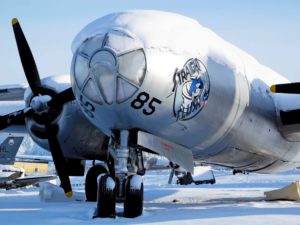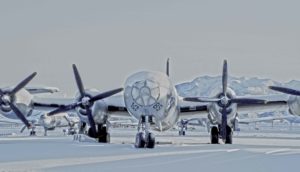Boeing B-29-55-MO “Superfortress”
S/N 44-86408
Crew: 9-14
Engines: Four Wright R-3350-23 radial; 2,200 hp each
Wingspan: 141 ft 3 in
Length: 99 ft 0 in
Height: 27 ft 9 in
Weight: Empty: 70,140 lbs; max: 135,000 lbs
Speed: Cruise: 220 mph; max: 365 mph
Range: 5,300 miles
Service Ceiling: 32,000 ft
Armament: Twelve .50-caliber machine guns; up to 20,000 lbs bombs
Cost: $605,360 (average B-29-unit cost in 1944)
Located at the Hill Aerospace Museum, the B-29 “Straight Flush” was one of 531 B-29’s manufactured by the Glen L. Martin Company in Omaha, Nebraska. This aircraft was delivered to the United States Air Force on August 6, 1945–the same day that the Enola Gay, aB-29 aircraft as well, dropped an atomic bomb on Hiroshima, Japan.
In June 1948, our B-29 moved to the 97th Bombardment Group, Strategic Air Command, at Biggs Air Force Base, Texas. One year later it transferred to the 4002nd Base Services Squadron, Strategic Air Command, at Campbell Field, Kentucky. In October 1949, the B-29 then moved to the 43rd Bombardment Group (SAC) at Davis-Monthan Air Force Base, Arizona.
The aircraft encountered several more transfer, and then In May 1953 the aircraft transferred to the Wright Development Center, Wright-Patterson Air Force Base where it remained until June 1953.
Following the B-29’s time at Wright-Patterson, the aircraft was relocated to Dugway Proving Grounds, Utah, for chemical munitions testing. In November 1953, the aircraft was dropped from the United States Air Force inventory while serving at Michaels Army Air Field, Dugway Proving Grounds. For the next 30 years, the aircraft would reside at Dugway, acting as a ground test vehicle for testing various types of chemical warfare agents.
Finally, in 1983, the aircraft came to the Hill Aerospace Museum, after it received all required chemical tests.


